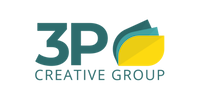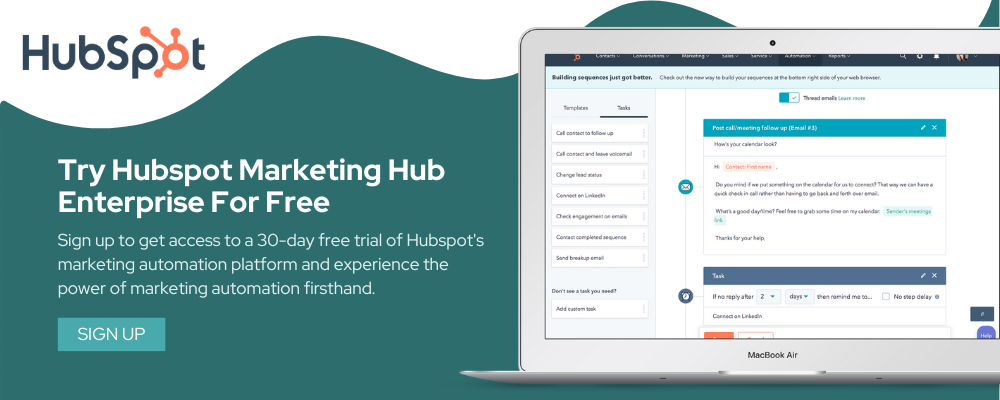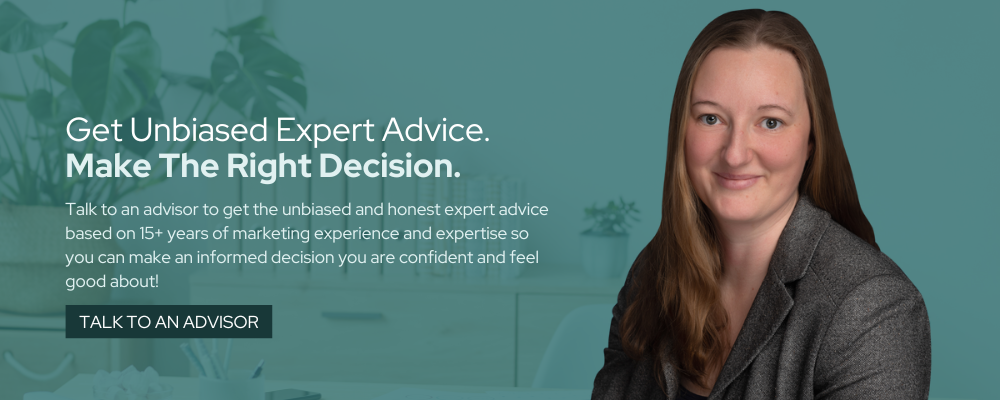Digital Marketing For Sustainable Building Companies
Introduction
Competitive & Consumer Pressures Are Drastically Increasing
The Green Building industry is, like many other related industries, in a bit of a tough spot right now. After years of fighting for a better way to build, sustainable building is now finally reaching mainstream adoption, resulting in a healthy 12% CAGR until 2030. But it isn't all puppies and roses.
The competition is rapidly increasing as consumer demand shifts. In addition to an ever-growing number of innovative green solution providers competing in a tight market, big "traditional" (we all know the word is wrong because traditional building methods were sustainable) firms are entering the market.
A recent Forbes study found that 47% of executives in the engineering and construction industries who were asked as part of this research said sustainability is top-of-mind or a major concern. Generally speaking, this is great news, but in reality, this often means they are simply adding a few environment-friendly materials into the mix when essentially greenwashing their offering.
Greenwashing confuses consumers who are already struggling with the amount of research involved in building a green home. All the mixed messages and half-truths make it even harder to make the right decision. Now, with soaring energy and wood prices coupled with supply chain issues, the pressure on the buyer to make an informed decision increases daily.
.png?width=1600&height=900&name=House%20(1).png)
The Solution: Becoming The Voice Of Trust In Your Industry
Regardless of whether you are selling a modular passive solar house kit or green architecture services, or you are a sustainable construction business, the one thing that every single business in the world needs to do is build trust, as this is the single most crucial emotion a buyer must feel to exchange their money for your products or services. It's that simple.
However, if you put yourself in the shoes of your buyers (and believe me, I know what I am talking about as I have researched how to build a passive solar house for the past four years extensively, first in the United States and now in Europe, as we moved), there aren't many reliable sources out there. As the consumer, you have to piece tiny scraps of often outdated information together (talking about frustrating!) and call one provider after the next, leading you to feel bad for having wasted each salesperson's time because the cost of their house was double what you had budgeted.
At the moment, there is not a single authoritative, unbiased, and up-to-date Voice of Trust that genuinely answers your buyers' questions and proactively addresses their concerns! This is a huge opportunity!
Below, I am going to show you how to develop a strategy that allows you, within the next 12-18 months, to become just that. There are no magic bullets or cheap tricks, so if that is what you are looking for, this isn't for you. But if you are not afraid of rolling up your sleeves, listening to your customers, and having a teaching mindset, then read on. This might transform your business and your entire industry.
The Basics Of Inbound Marketing
Today's Digital Buyer Will Complete 80% Of The Purchase Decision Process Without Contacting Sales
Studies have shown that 80% of the purchase decision is already completed by the time your buyer contacts your sales team. Pause and let this sink in for a moment.
This means that your prospect has already extensively researched solution approaches (e.g., modular vs. non-modular, strawbale vs. other construction methods), has already eliminated some of your competition, and now has (hopefully) shortlisted you and decided that you are worth calling.
On the flip side, this means that you have absolutely no control from a sales perspective to make an impact on that person until they call you, fill out a "Request a quote" form on your website, or walk into your office.
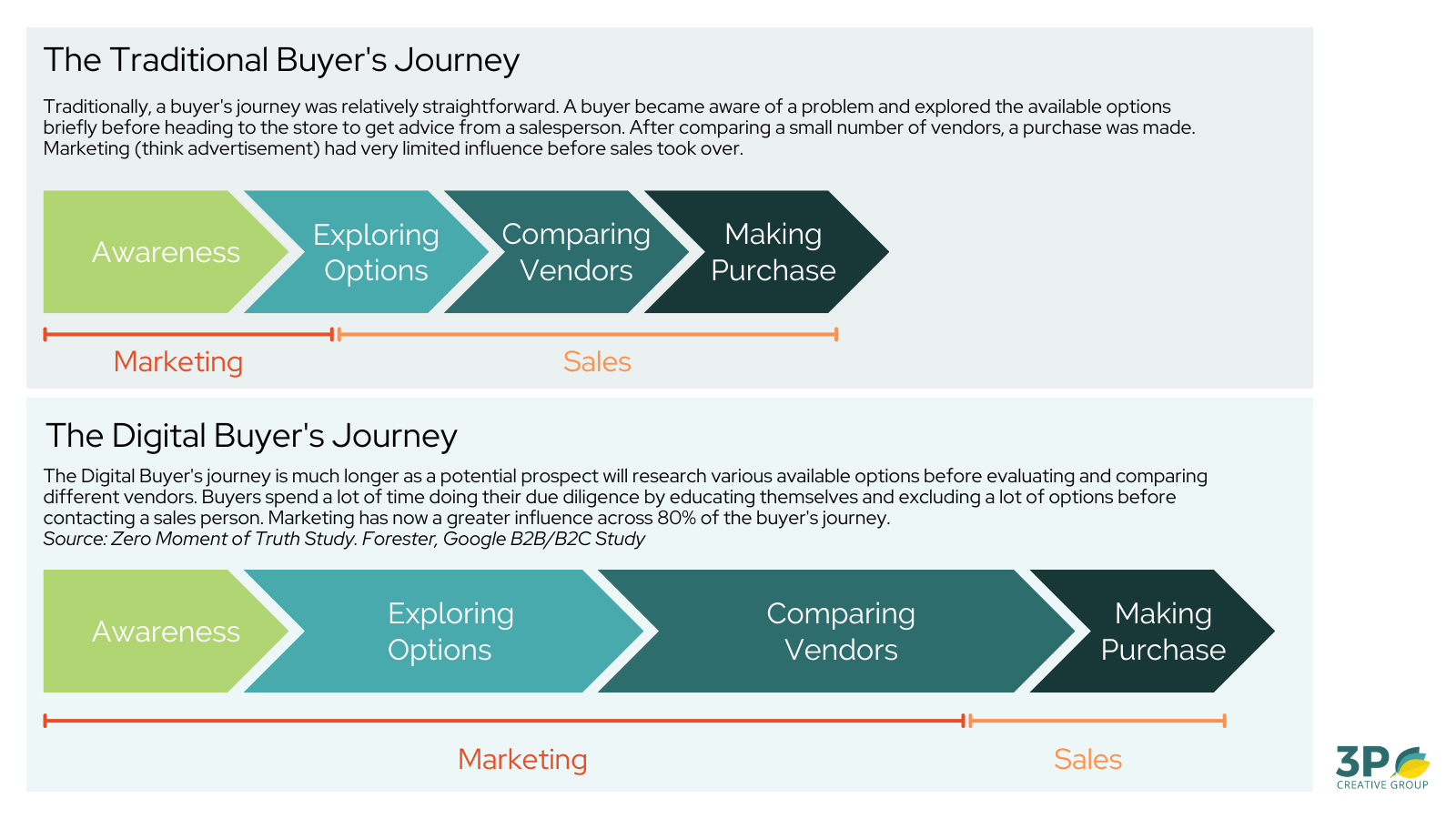
Now, think about what that means from a marketing perspective! If you don't show up or your content doesn't answer the buyer's questions, you are out of the picture — and there is nothing you can do about it. But if you are the "Voice of Trust" providing authentic, unbiased, and educational content, what do you get? That's right! You get their phone call and, in the best case, their business.
Inbound Marketing: Building Trust By Providing The Educational Content Your Digital Buyer Is Looking For, When & Where They Are Looking For It
Inbound Marketing is a digital marketing approach that acknowledges and embraces the fact that today's buyers have changed. Instead of forcing random marketing messages on unqualified buyers and wasting advertising money in the process (e.g., through TV ads, billboards, and magazine adverts), the goal of Inbound Marketing is to provide buyers with the information they need where they are looking for it (e.g., search engines, social media, etc.).
This is important to understand because if a consumer is searching for something that your service or product will be the answer to, and they find your content on Google, read it, and find it helpful, then they are more likely and willing to trust your company and therefore further consider it.

To accomplish this, Inbound Marketing looks at each stage of the buyer's journey and creates targeted content for a clearly defined profile of buyers (we call this buyer persona). To better illustrate what I mean by that, let's look at each stage:
Awareness Stage
Buyers are aware they have a problem, but they don't know how to solve it yet. For example, they know they want a non-toxic and safe house to raise their children in, and they also heard they can significantly lower their heating and cooling costs by choosing a sustainable house. Because they don't know terms like "Passive House" yet, they could be looking for "sustainable house options", "building an energy-efficient house", or "what must a sustainable house have". As you can see, these terms are very general and broad.
Consideration Stage
As the person deepens their knowledge through research, usually, a few solution approaches evolve that they will now consider. They will now try to narrow down their list and decide on a direction in which to go. Their searches could include "passive vs. passive solar house", "advantages and disadvantages of passive houses", or "potential problems of passive houses". At the end of the consideration stage, the buyer has decided on one or two ways to solve their problem and will now start looking for vendors to buy from.
Decision Stage
In the decision stage, a buyer will look through a list of potential vendors to partner with to build their house. Now, cost, production and shipping times, and building plan details become a factor, and searches become very detailed and increase not only in frequency but also in impact.
The point is that your customer is going to search for answers to dozens if not hundreds of questions, and the company that provides those answers is building trust. The more trust you can build, the more likely it is that you will get a phone call, a form submission, and maybe a signature on the contract.
In the next chapters, we will have a closer look at how you can build such a content-driven strategy that will not only attract people to your website, but also build the confidence and trust needed for the visitor to become a lead and, finally, a customer.
The Benefits of Inbound Marketing
There are many tangible advantages to implementing Inbound Marketing in your sustainable building company. Here are the top five:
- Build a competitive edge. By creating educational, high-quality content that appears high up in search engines and engages your audience, you build a competitive advantage that is hard to re-create. By putting in the work now and becoming that Voice of Trust, you give your organization a step up — a move from which you will reap the benefits for a long time to come.
- Better fit buyers. When a buyer finally reaches out to you, you want them to be as educated as possible. Not only does this minimize any misconceptions or assumptions that might occur during their research process, but this also ensures that they have a good idea of what they want and don’t want. By educating themselves, buyers are also able to self-select, which makes them a better fit when they do contact you as they have consciously and knowingly eliminated other options and have chosen you.
- Lower price sensitivity. Because your prospects are educated, they also understand (or are at least somewhat aware of and curious about) what goes into your product or service, what makes the price go up or down, and why there are pricing differences in the market. This lowers the price sensitivity.
- Faster sales cycles. It is very common for sustainable building companies to have very long sales cycles. However, through Inbound Marketing and an inbound sales process (see below), you answer the generic sales questions that always require the same response, freeing up your salespeople to get to the things that matter to your buyer most and add real value as soon as possible. Something that previously took six to twelve months can now be accomplished in weeks, sometimes even just days.
- Better likelihood to close. Did you know that studies have shown that a prospect who reads 30 pages of content has an 80% likelihood of closing? We will discuss in chapters 4 and 5 how to get your buyer to read that content, but the point is that you have earned your buyer’s trust and they are more likely to buy from you than from your competition.
Can you imagine the impact this would have on your business? It’s great, right? Alright, let’s finally get to the point where we put all the pieces together and show you how it's done.
Supporting content
Become A Content-Driven Organization
Before we discuss how to build your content strategy and how to put it all into action, let’s get you set up for success!
Get Full Company Buy-In First
In our experience, some marketers want to skip this step because they feel that it is easier to convince their boss with results. Meaning well, they implement Inbound Marketing in the hopes of showing results that would win their management over. But we have found that Inbound Marketing requires buy-in from the entire company and the full support of your sales team to be successful. You simply won’t get the same results if you don’t get everyone on board.
The best and easiest way to get everyone’s support and buy-in is to hold a company-wide Inbound Marketing workshop. The goal is for everyone in the organization to understand how the buyer has changed and why every company is now a media company. Secondly, the workshop should aim to align sales and marketing teams in an effort to integrate both teams into content creation.
Sometimes, it is easier to have an outside voice come in and conduct this workshop than it is for the marketing team to try to convince sales to “do things differently from now on.” A lot of our customers find this tremendously helpful, not only in starting their content efforts but in defining what kind of company they are going forward.
In-Source Your Content Creation
After years of outsourcing content creation to niche freelance writers at inbound marketing agencies, companies are becoming increasingly frustrated and, therefore, careful about who is creating their content, as outsourcing has, more often than not, resulted in fluffy, subpar content that doesn’t rank anymore with search engines or readers.
Most organizations don’t realize that the content creation part can be taught more easily than the intricacies of your industry. You have an enormous amount of subject matter expertise already in-house (for example, from your salespeople); you just need to bring it out to shine.
The trick is to find (or hire) someone who can manage the entire content creating and publishing process from beginning to end. This person guides the sales team and other subject matter experts through regular brainstorming sessions to come up with and prioritize content topics, interview your subject matter experts, and give them a voice that is consistent with your brand. They also help the salespeople decide when and how in the sales process the content will be used, monitor organic traffic, and measure the content performance.
Make Content A Non-Negotiable Part Of Your Sales Process
I know many companies are hesitant to send out information before the sales appointment because they want to "explain it". But the fact is that the Digital Buyer gets very frustrated by this hesitancy. Studies have shown that they need to read more than 30 pages to be ready to have a productive sales conversation, yet the average website in the industry has only 12 pages, including "Contact Us" and the home page.
And think about your last few sales appointments. How much time did you or your salespeople spend on answering questions where the answer never changed no matter which client you spoke to, e.g., energy efficiency data, general shipping and construction timelines? How much time was there to address the specific concerns of that particular client?
Imagine how much more valuable this appointment could be if:
- You answered all generic questions before the appointment (e.g., by asking them to read a buyer's guide).
- They could watch a video of one of your houses being built from beginning to end, including set up, construction/installation, and clean up. (See below — Ecokit.us is doing a great job showing the construction process via video.)
- The buyer could already share details about their project with you ahead of time.
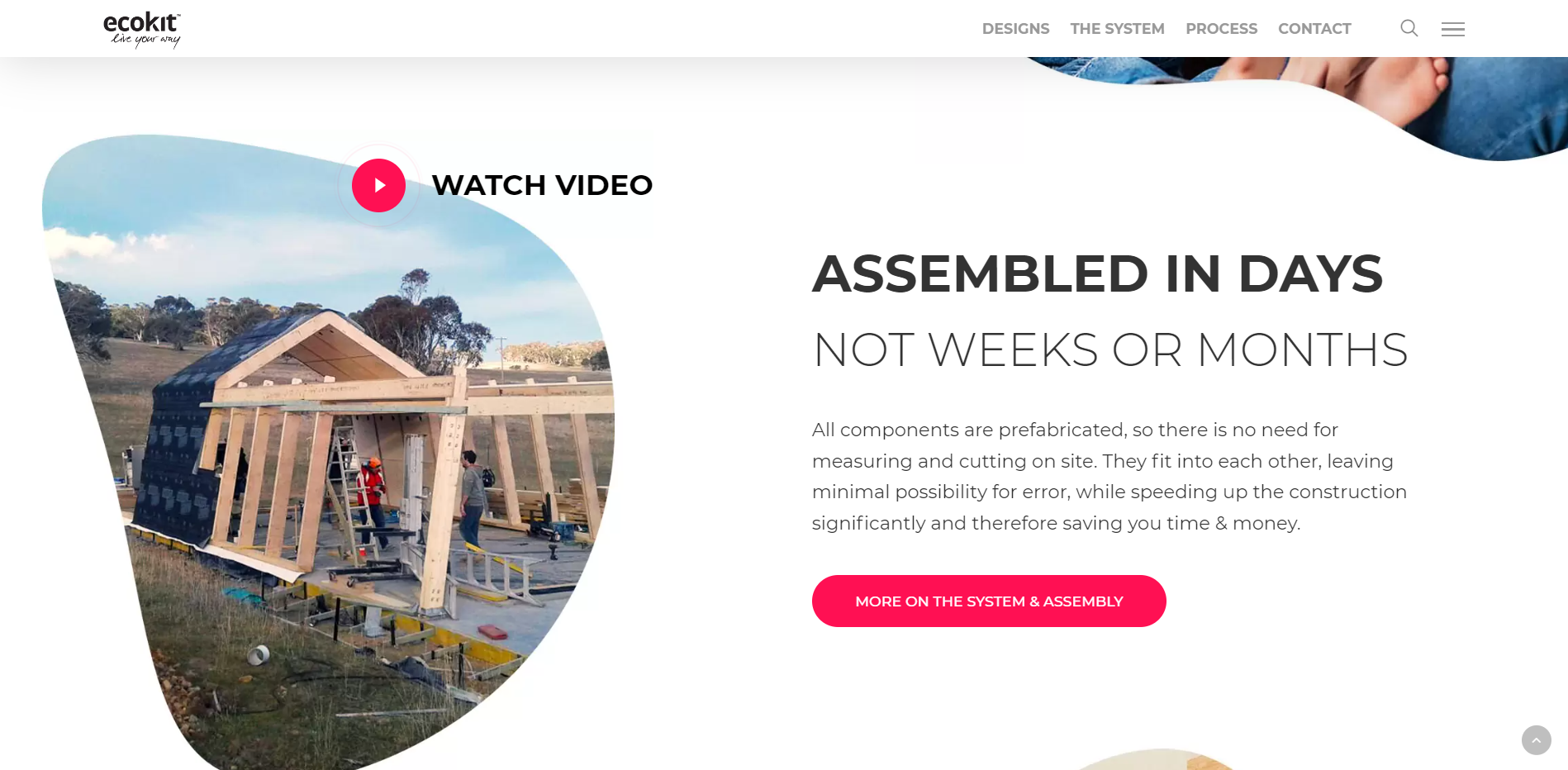
Essentially, you, as the salesperson, assign the client "homework" at crucial moments during the sales process with the goal of proactively answering their questions and concerns. We call this "Assignment Selling", which is a highly effective sales method with the new Digital Buyer. The content needed for this, for example, the buyer's guide or the video, is referred to as sales enablement content. We will talk about this in further detail below.
The important takeaway is that content and assignment selling need to be a non-negotiable part of your sales process.
How To Craft A Content Strategy That Will Perform
Now it is time to pull it all together and put pen to paper to craft a content strategy that outperforms your competition. As you might have guessed, your starting point is always your ideal customer.
Who Is Your Ideal Client (And Who Is Not)?
As a team, sit down and write what that person looks like. While orienting yourself on real clients you loved working with in the past is sound, try to build a realistic representation or profile of that ideal client. Is it the father of a family with both parents in remote corporate jobs and two small children looking to move to the country and have a garden and a few chickens? Or is it a middle-aged couple looking to build a retirement home close to their favorite hiking spots? Try to be as specific as you can. You can use HubSpot’s handy Make My Persona tool to help you.
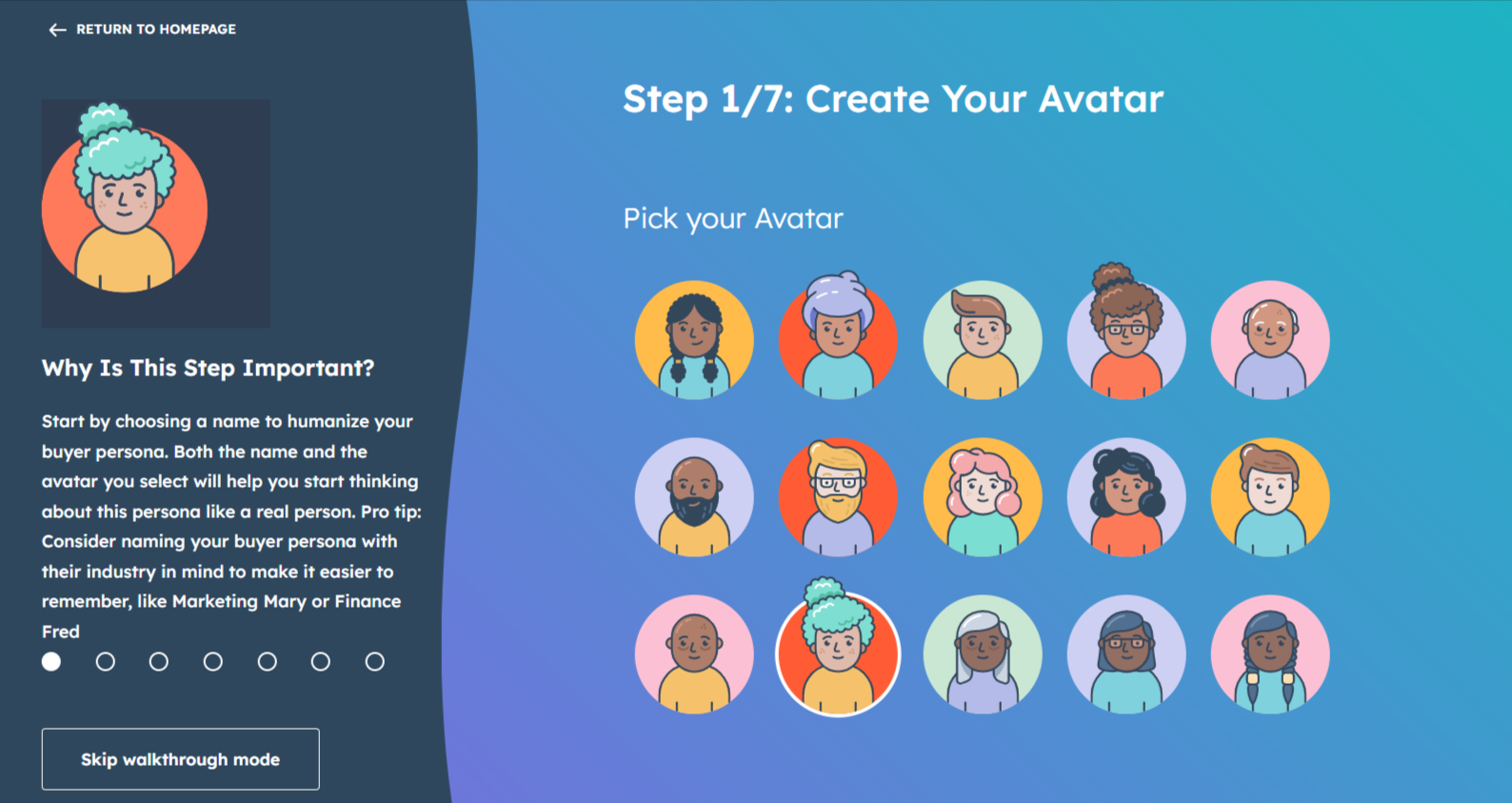
Businesses usually have two to three primary buyer personas. If you have more than that, try to prioritize and focus on just a few! Once you have defined whom you want to focus on primarily, it is helpful to talk about and document whom you do not want to talk to. There may have been a type of client that was a waste of time in the past. That is called a negative buyer persona. This is helpful for the entire organization, e.g., marketing can avoid creating content that speaks to this persona and sales can spend less time on them.
Write Down All The Questions Your Customers Are Asking
Now that we know whom we would like to talk to, let’s write down all the questions you have been asked in the last year or so. Ask sales to go through their past emails and jot down any questions. You could even ask them to keep a tally of how many times each question came up to prioritize them. Then sit down as a team (sales, marketing, support, product & engineering, management, etc.) and brainstorm other questions.
This way, you can quickly come up with 100-150 blog post topics, video titles, podcast episode names, etc., in just an hour or two. Now, could you prioritize them and build a content calendar? You can use Trello, Monday.com, Asana, or simply an Excel spreadsheet or Google Sheets to schedule them and keep track of their publication status.
Plan Your Content Creation Strategically
If your marketing is small, aim for at least one Big 5 article or video (see below) a week. Also, try to plan your content strategically so you can create content clusters and pillar pages. This will not only help you organize your content in an easy-to-consume fashion (think table of contents in a book rather than random blog articles) but will also help you to rank better. Additionally, you can find creative ideas on how to reuse content, for example, in the form of webinars, guides, or eBooks.
The Big 5: Tackle The High-Impact Questions First
“Okay,” you say, “so far, so good. But where do I start?” You probably have dabbled in inbound marketing before reading this page. You might have written some blog posts, crafted social media posts, and maybe even created some videos. But you didn't see much happening after an initial bump in traffic. This widespread problem has led many marketers to turn back to outbound marketing because at least when you pay for ads, you know you will get some traffic, right?
But don’t get discouraged; you are not alone! To create content that drives traffic to your site and, more importantly, generates leads and, therefore, revenue, you need to focus on the right topics. We have found that five topics have the most significant impact:
1. Pricing & Cost
One of the first questions your buyers will research is “How much is it going to cost?” They know that you know the cost and get very frustrated if they cannot find it on your website because they feel like you are hiding the pricing on purpose. And how do we feel when someone is hiding something from us? We trust them less. And we want to build trust!
Usually, when I talk about addressing pricing on websites in this particular industry, I get one of two responses: "I cannot put pricing on the website because it depends on many factors” or "We have a basic price on the website."
Let's talk about the first argument. If you have a product or service that truly is so complex, you can give an average or starting price per square meter/foot and then explain what additional costs to expect (e.g., shipping and transport, construction, or installation) and what could impact the costs.
However, in the sustainable building industry, most companies do provide a very rough estimate already. But they need to explain in detail what is involved. The average person doesn't know what the costs for a foundation or a basement are, or how much the required site work will set them back. Not only will you have more informed and happier buyers who trust you, but your salespeople will spend less time going over the same questions again and again.
For example, Bright Built Homes explains what to expect regarding costs for the house site, the house itself, and the extras in great detail. This is a great educational article. To make it as user-friendly as possible, consolidate this information into a pricing page linked on the first level of the main navigation. Remember, the average searcher expects to find pricing information within ten seconds.
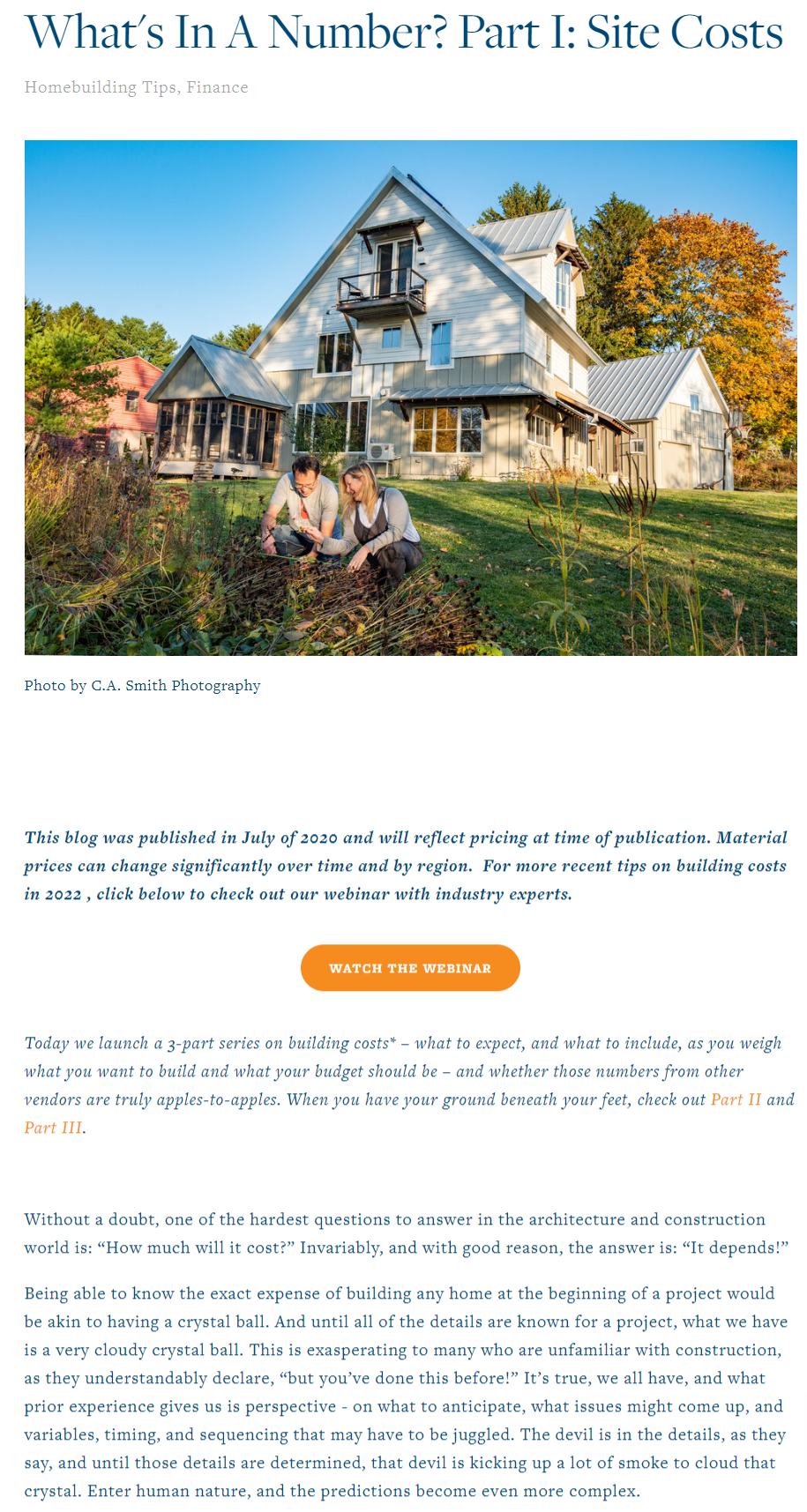
2. Problems With Your Products Or Services
Before you say, “I am not talking about any problems with my products or services!” hear me out. Although we wish everything would always go smoothly, we know that there are specific issues that could occur. For example, well-insulated building envelopes of zero-emission buildings and passive houses may cause an increase in moisture levels and thereby increase the risk of mold growth.
Our buyers will research potential problems, and if we are not addressing them head-on in an educational, unbiased fashion, they will find the information somewhere else, and … we lose all the trust we have built so far because now we seem like we are hiding something.
A good example of answering those questions is Ecococon. While they don't (yet) address these questions in their blog, they have a highly visible Frequently Asked Question section that answers difficult questions, e.g., "Do EcoCocon buildings attract rodents and insects?" head-on in a concise fashion. My advice? Go much deeper using video to show and text to explain in detail what the problems could be and how you address them.
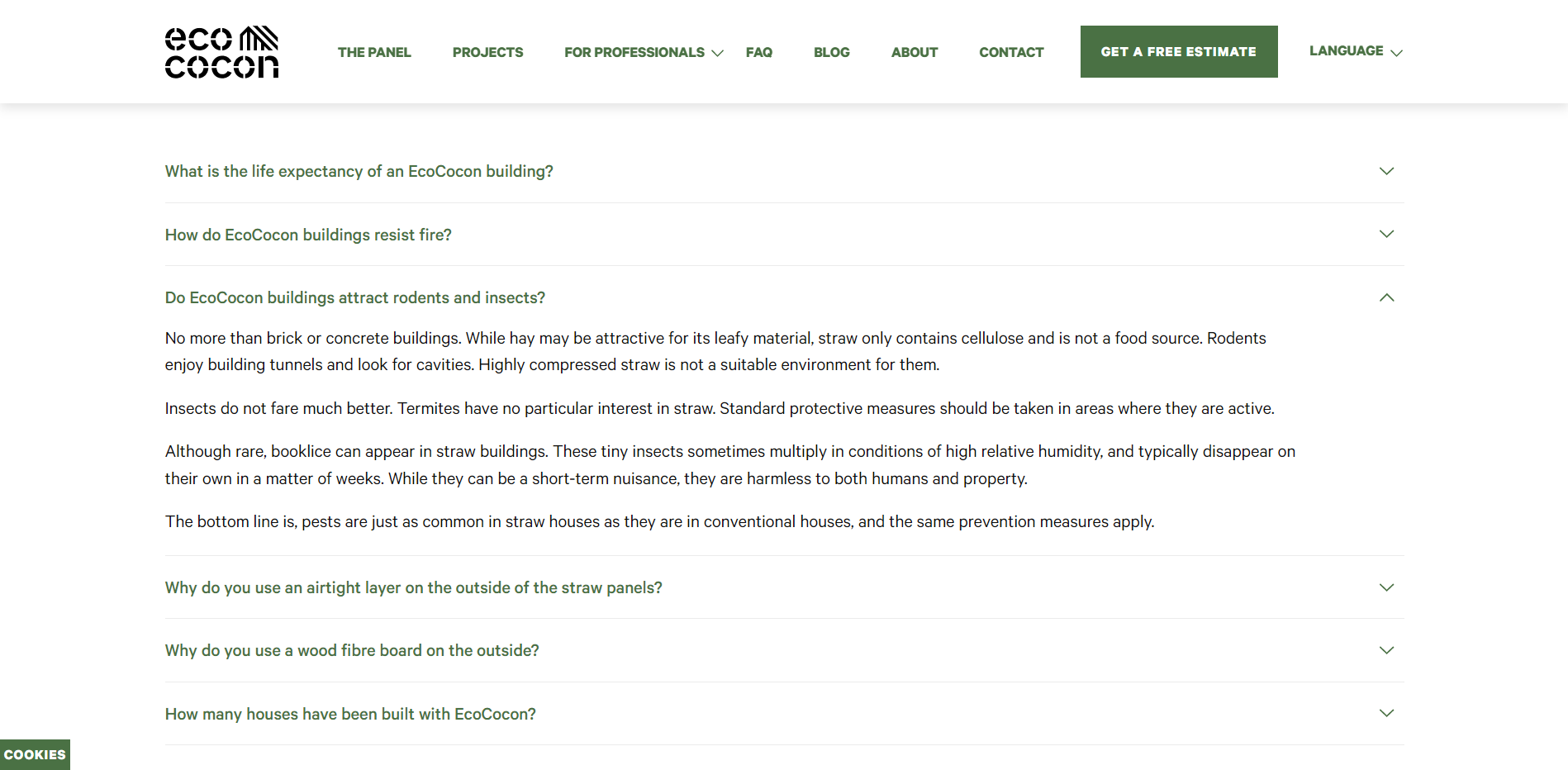
3. Versus & Comparisons
Although you, as a company, have very good reasons to be in your niche and offer your particular product or service, your buyers will need to compare different solution approaches before they know they are making the right choice for them. Provide them with all the information they need to make the right decision by explaining the differences and similarities between the different options, as well as the pros and cons of each. An example of this could be “Passive vs. Passive Solar Houses: A Side-by-Side Comparison” or “Eco-Friendly Pre-Fab vs. Kit House.” Think about which solution approach you are selling against and provide an unbiased, honest comparison.
4. Best In Class
Have you ever encountered a situation where you thought you were about to close the deal but, at the last moment, your prospect said something like “I really like your company, but before I commit, who are some of the other firms out there?” Buyers want to know what/who is the best in class; it helps to prevent buyer’s remorse or the sense of regret after having made a purchase. Even if they cannot afford or do not need the best option, we as humans tend to be wired that way. We want to know what “the best” looks like and how close we can get to it. Help your clients understand what their other options are.
I couldn't find an example in the sustainable building industry, so I included a screenshot of an article called Who Are The Best Pool Builders in Richmond, Virginia? from the master himself, Marcus Sheridan. Marcus was a pool guy (he still is a silent partner in River Pools and Spas) when he discovered the power of answering the questions that moved the needle. Notice how they are not including themselves in the list (because they would make it a biased list and erode trust, right?) and don’t go into much detail about their competition.
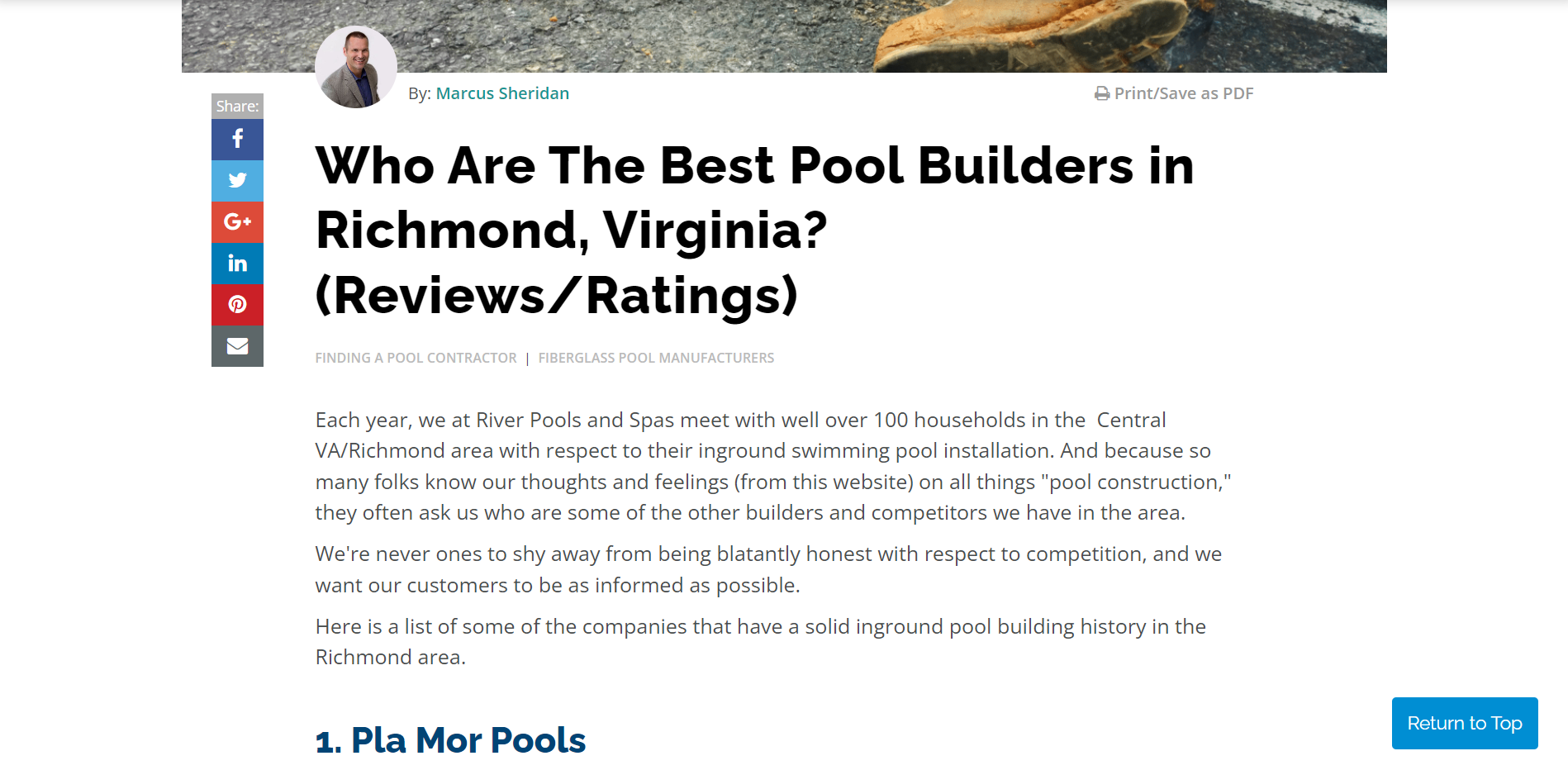
5. Reviews & Ratings
We look at reviews before making a reservation at a restaurant, downloading an app, or purchasing something on Amazon. Of course, we also would appreciate reviews and ratings before making such a significant decision about whom to work with regarding our new house. Of course, that isn’t as easy as going on Yelp. But you provide your buyers with a clear and honest picture of what it would feel like to work with you.
Go over your process in detail, describe who is and isn’t a good fit for you, and explain what they should expect should they decide to partner with you. Buyers appreciate it when companies take the time to explain it this way. And don’t be afraid to turn people off. If they choose to go with someone else, lucky you — they weren’t a good fit anyway.
Supporting content
How To Get Started
Now, finally, it is time to roll up your sleeves and get started! Don't let perfection stand in the way of progress. As my permaculture mentor, Joel Salatin, always says: "If a job is worth doing, it's worth doing it poorly first."
1. Get The Tools You Need
To get started, you don't need something fancy, but we do strongly recommend using a tool that not only allows you to track page views and visitor sessions, but allows you to measure visitor-to-lead and lead-to-customer conversion rates. You will want to know much each article, video, and sales enablement asset contributed to your revenue! This is the only way to know what works and what doesn't, allowing you to invest only in the things that achieve a high ROI.
As a certified HubSpot Solutions Partner, the tool of choice for us is HubSpot because it allows us to create a seamless working relationship between marketing and sales that revolves around the customer. The Hubspot Marketing Hub Professional includes everything you need to run this program: blog, social media, email, marketing automation, and so much more.
In addition, you will need some basic video equipment and editing software. However, if you are just starting out, a free Vidyard account will do for now; there is no need to purchase top-of-the-line lighting, etc.
Hubspot Marketing Hub Professional: $800/month
2. Hold A Marketing & Sales Alignment Workshop
Before you start writing, be sure to hold an internal marketing and sales alignment workshop. We recommend that management, every single salesperson (yup, especially your old school sales guys), all marketing team members, and whoever else will serve as a subject matter expert or is involved in revenue generation attends. You can do this entirely by yourself or bring a coach in to guide you through the process and hold the workshop for you. We have found that organizations have an easier time with change if the voice comes from the outside.
Workshop Cost if done with an external coach: $3,000 - $10,000 one-time investment
3. Start Writing :)
All right, time to get to work. The best advice I can give you with regard to Inbound Marketing is to get started. Put yourself in your buyer's shoes and start working through your lists of questions one by one. How would you want a company to answer them if you were the client? If recording/editing videos still feels way out of your comfort zone, get your feet wet with crafting blog articles first and aim to start with videos in six months.
Content Manager Salary: 35,000-60,000 (greatly depends on location)
Editor: $20-30/hour (Although an editor in invaluable to great content creation, start with Grammarly for the first three months.)
4. Consider Bringing In A Coach
If you feel like this is the right way to go, but you and your team don't have the time to learn all the ins and outs for yourself, or your organization wants to implement this in the most effective way possible with an expert to guide them along the way and hold them accountable, consider bringing in a coach. Here at 3P Creative Group, for example, we offer an 18-month program after which you graduate with all the skills, expertise, and experience you need to do this yourself and be highly effective.
Coach: $5,000-$8,500/month for 18 months
I hope this helps you in your quest to change the world one house at a time. If you need any help implementing any of the above-mentioned inbound marketing strategies, set up a time to talk to an advisor today. Our mission is to eliminate the guesswork and help sustainable builders, passive (solar) kit manufacturers, green architects, and others to finally be successful in content and inbound marketing - while investing in your business, not a marketing agency.
Contributors:
From Our Blog
Stay up to date with what is new in our industry, and learn more about the upcoming products and events.

From Trust Out Of Necessity To Distrust By Default: How Trust Evolved Over The Last 50 Years
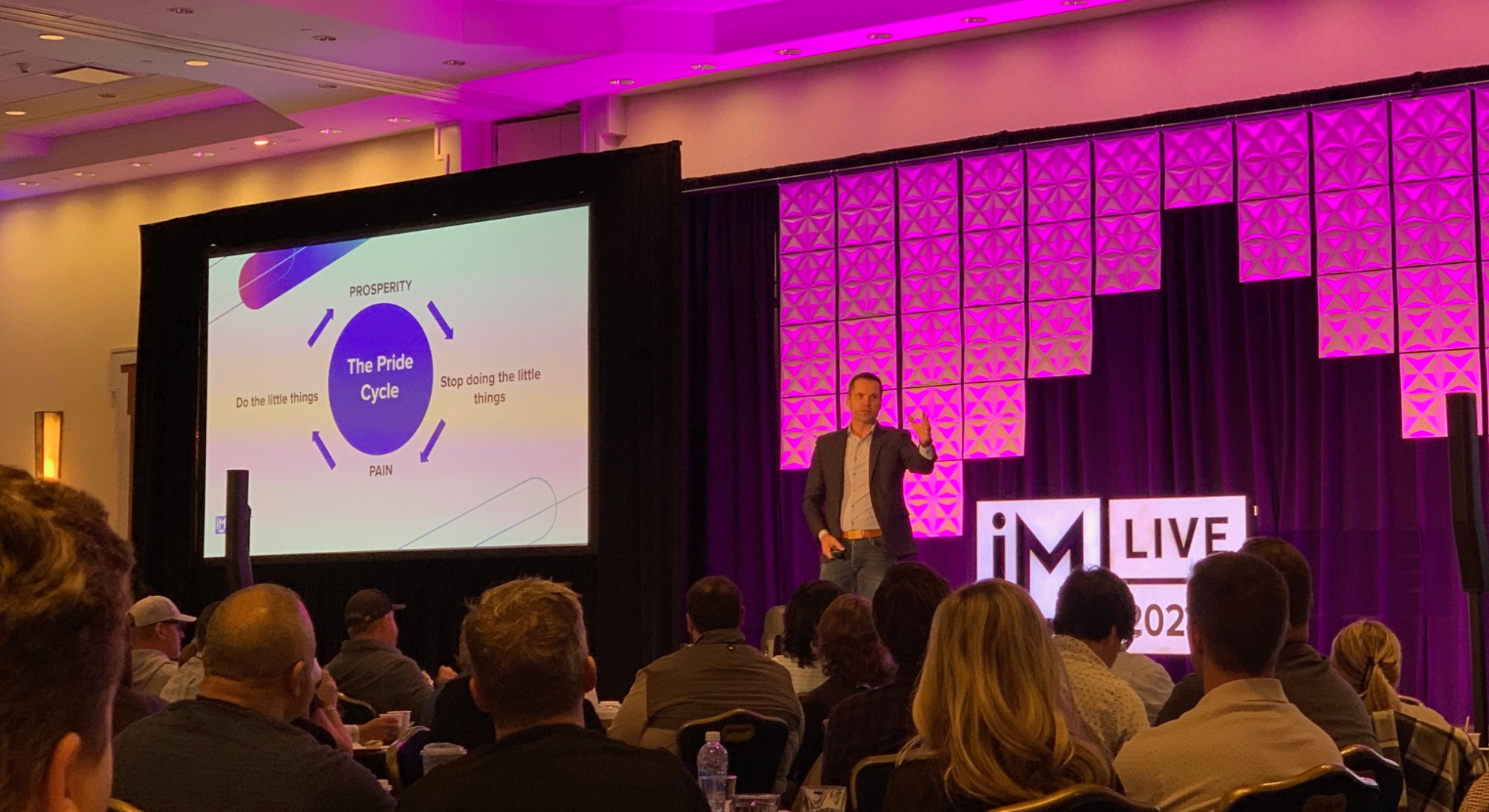
The Key to Building Trust in a Zero-Click World: Highlights from IMPACT Live


